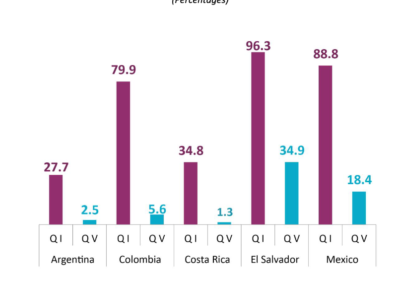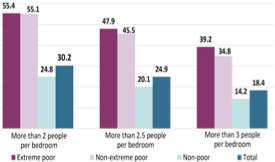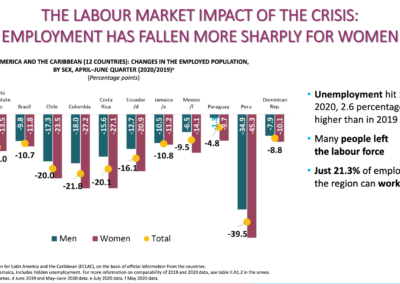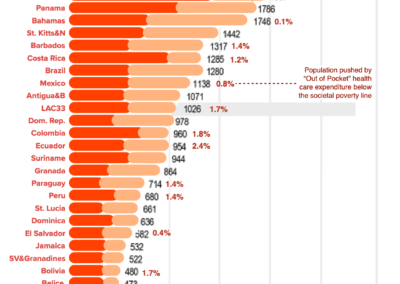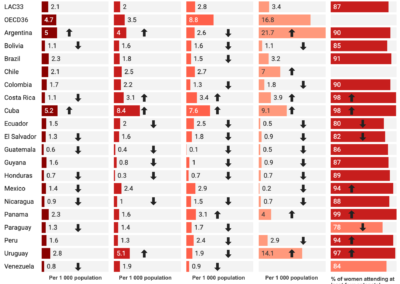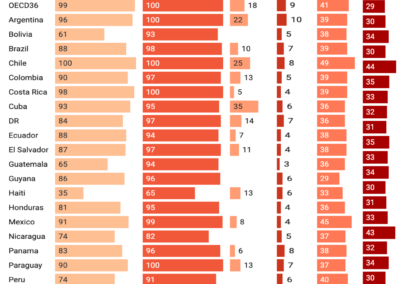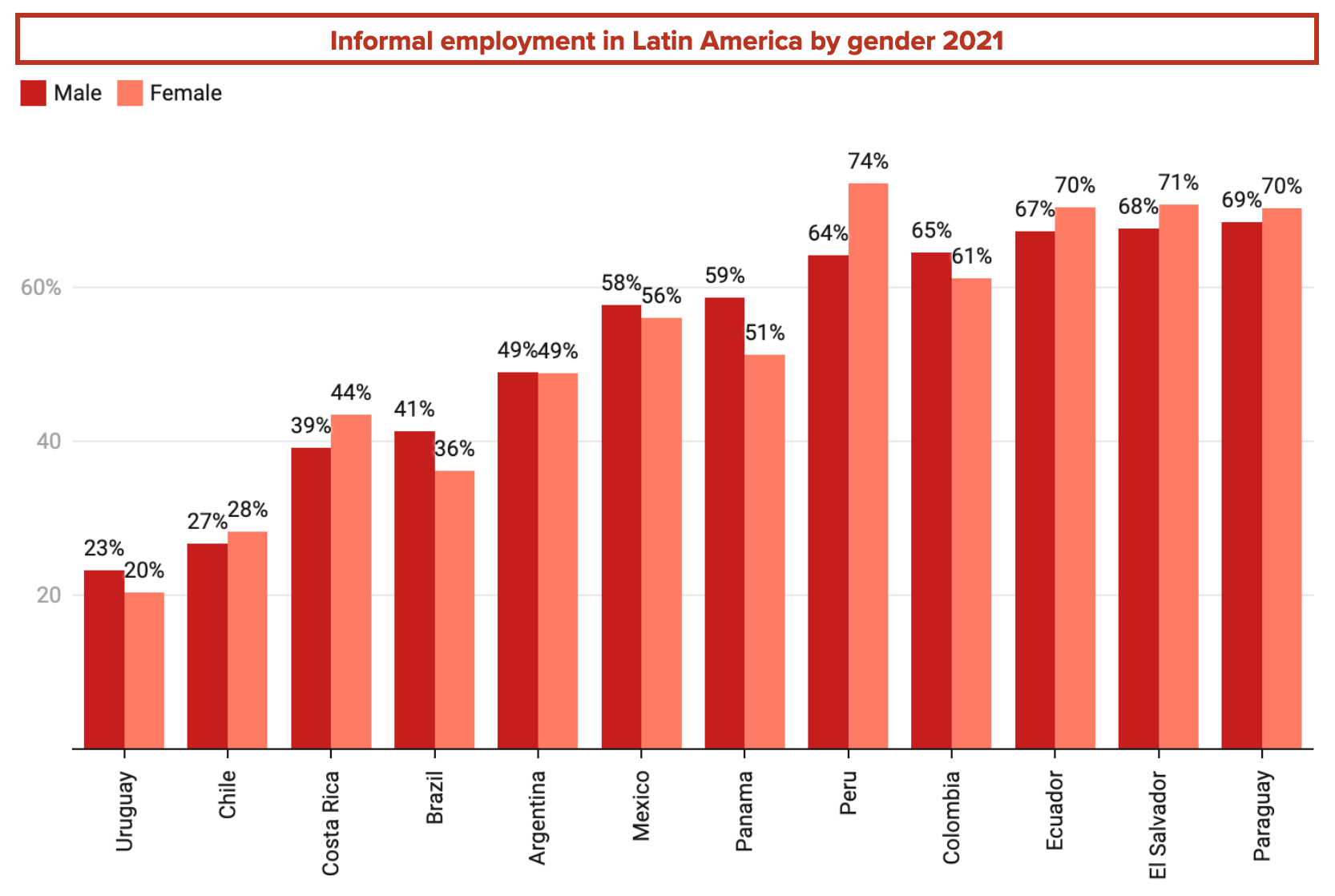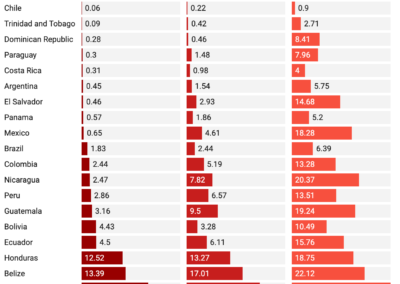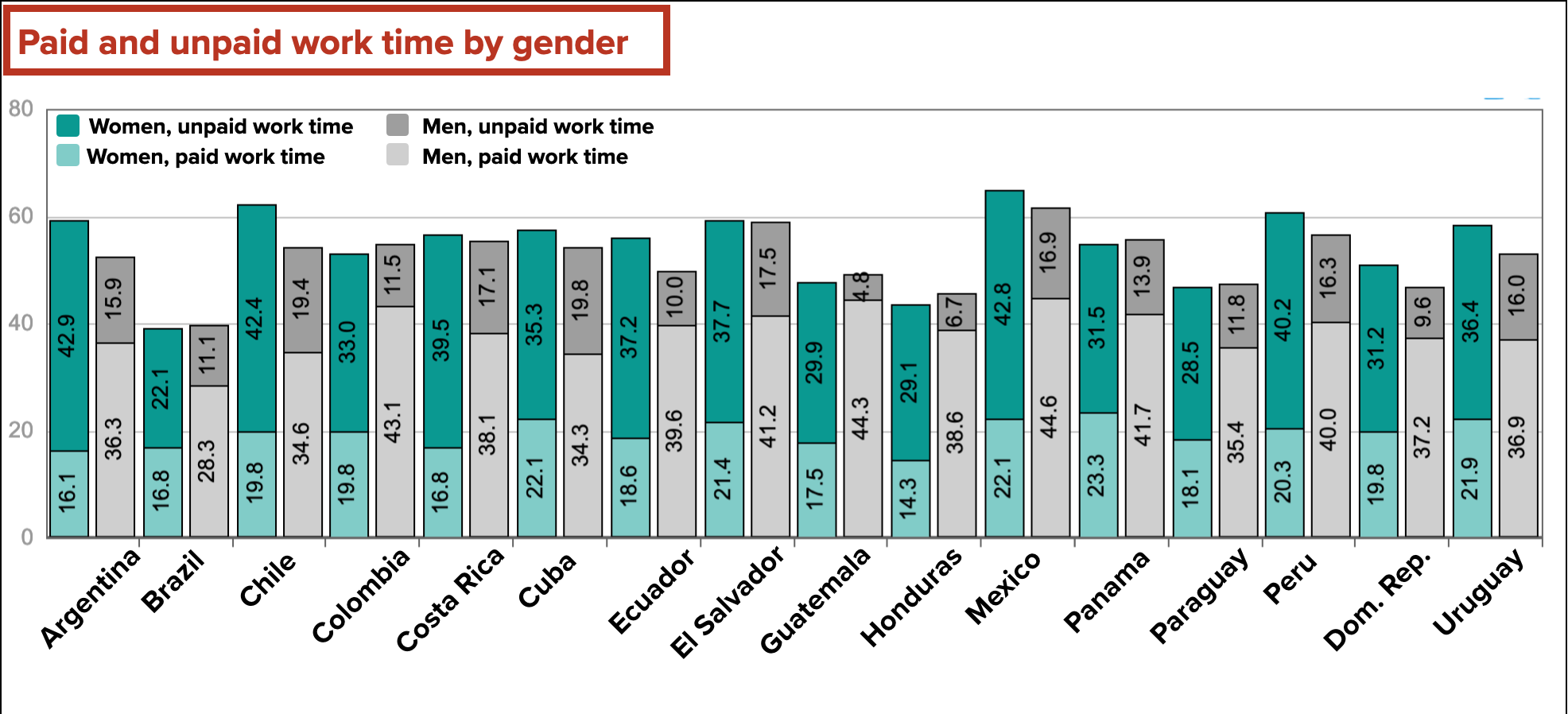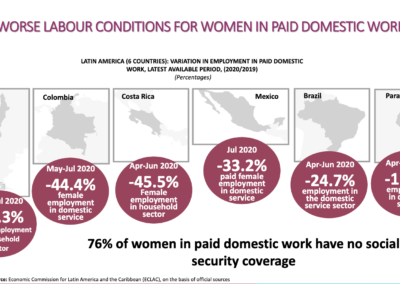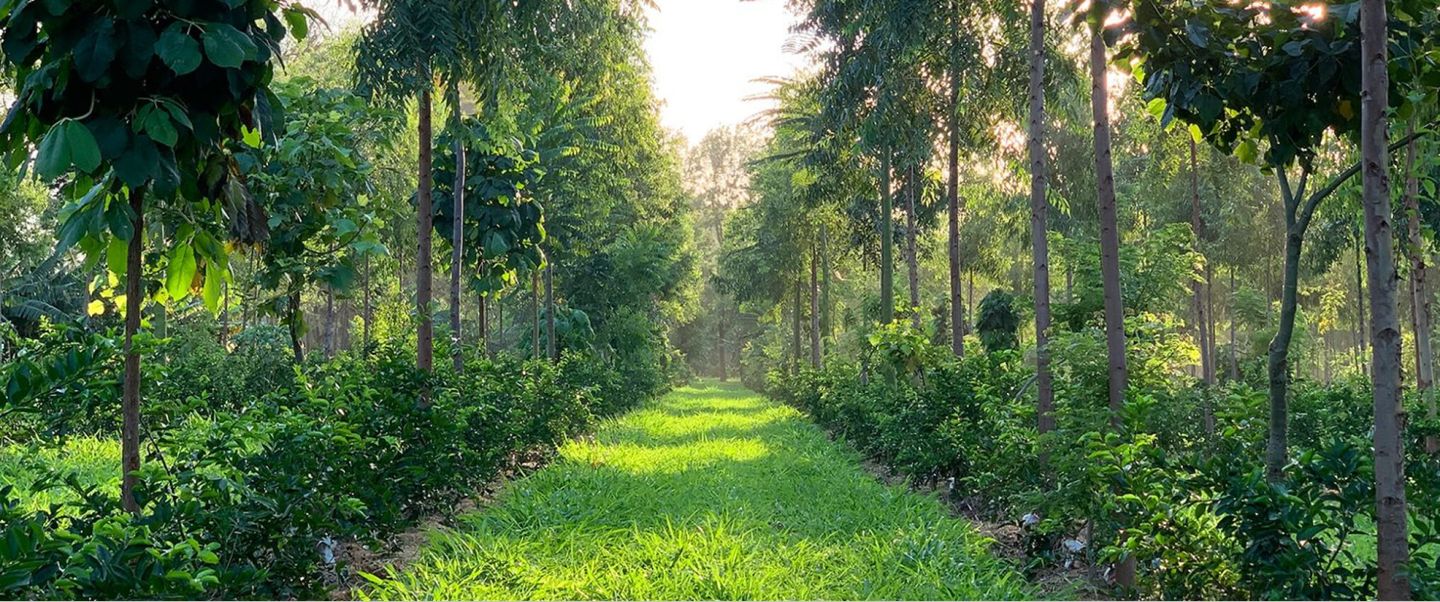2022 report
Change & Emergence
in Latin America
Well Being
Current Situation
COVID19 showed the frail scaffolds of wellbeing in Latin America
Health. Latin America and the Caribbean are home to 8.4% of the world’s population but registered 27.8% of COVID-19 deaths worldwide. Two major factors, that has not been fully addressed after these great amount of losses are:
- Fragmented, unequal and underfunded health systems that lack human and technological resources and infrastructure.
- Slow and unequal access to vaccination.
Education. The UNESCO estimates that 167 million students were affected by school closure in 2020. According to ECLAC the education gap between high and low income families also grew wider due to unequal access to internet service.
Living conditions. Household overcrowding had played a major role during the pandemic. In 55% or more of urban poor households, there are 2 or more people per bedroom. In more than one third, there are 3 or more people per bedroom.Employment and wealth. Employment has fallen more sharply for women, also just 21.3% of employed people in the region can work remotely.
Source: 4.1 CEPALSTAT site, 4.2
B. Children (5-12 y.o.) access to internet in their household 2020 (QI richest quintile against QV poorest quintile).
Current Situation
Selected problems snapshot
Introduction
Argentina has long struggled to rein in fast-rising prices with inflation currently running at an annual rate near 80%. The government has pushed retailers to freeze some prices, with some supermarkets rationing purchases of staples like flour, sugar and milk but shopping costs have nonetheless soared.
Current Situation
Selected problems snapshot
Health panorama
Universal health coverage (UHC) is achieved when all people, communities and social groups have access to health services they need, that these services have a high degree of quality, and that users are not vulnerable to financial hardship through the use of health services.
A. Health spending composition- 2018. Payment per person in USD
B. Health coverage and services
Access to health care depends firstly on whether there are enough resources available to provide the necessary care. The dashboard illustrating progress in the coverage and services dimension uses one indicator of medical infrastructure availability, three indicators of human resources availability and one indicator of coverage for maternal and child health services
C. Determinants of health
Health status depends not only on the provision of health care, but also on the behavior of people and the environment in which they live. The five indicators presented in this dashboard offer an overview of the prevalence of risk factors or behaviors and of environmental factors that affect health.
Source for all figures are from OECD report “Health at a Glance: Latin America and the Caribbean 2020”
Education panorama
Education opportunities are unequally distributed.
- About 63% of young people complete secondary school but in 20 countries the richest 20% are 5 times as likely as the poorest 20% to do so. In Guatemala, 5% of the poorest complete secondary school, compared with 74% of the richest.
- For every 100 females, 93 males completed lower secondary and 89 upper secondary education.
- School attendance rates are lower for young people with disabilities, indigenous language speakers and Afro-descendants.
Education outcomes are unequally distributed.
- One in two Latin American 15-year-olds does not achieve minimum proficiency in reading.
- In the Dominican Republic, Guatemala and Panama, fewer than 20 of the poorest 15-year-old students for every 100 of their richest peers achieve minimum proficiency in mathematics.
- Gaps in reading scores exist between immigrants and native speakers of the main language. In Buenos Aires, Argentina, the gap was 36 percentage points in 2015.
Greater efforts are needed to gather more useful data on those left behind.
- The Caribbean has low coverage in household surveys (only 4 of 21 countries have had a publicly available survey since 2015) and in cross-national learning assessments (only the Dominican Republic participated in the 2018 PISA).
- Only six Spanish-speaking countries in the region incorporated an ethnicity question in their census in 1980; today, all except the Dominican Republic have such a question.
- Chile, Costa Rica and Suriname have introduced survey modules on disability that are consistent with a social rather than medicalized model of disability.
Of particular concern are young people who are neither in employment nor in education or training – known by the acronym NEET in many countries, “disconnected youth” in the United States and “ni-ni” (neither-nor) in Spanish-speaking countries.
This group has been growing since the onset of the crisis, reflecting an increasing detachment from the labour market among young people.
In the region 18.6% of young people aged 15 to 24 are neither in education nor employed, a percentage that reaches 26.1% among women. The main reason are unpaid care work at home, in the case of women, and unemployment or fist-time job searching among men.
Credit: Global education monitoring report, 2020, Latin America and the Caribbean: inclusion and education: all means all, key messages and recommendations doc
Source: ECLAC 2020
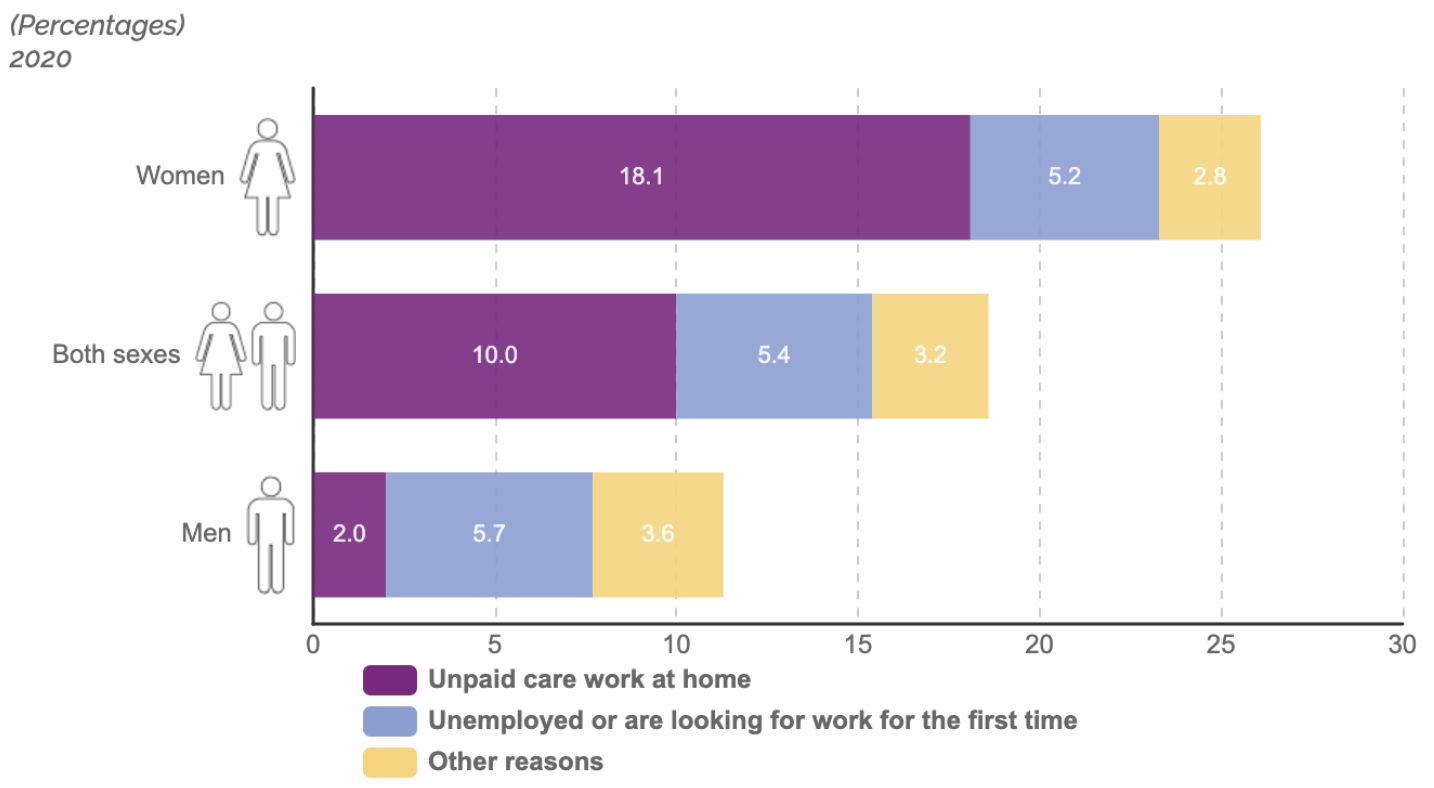
A. Young people aged 15-24 who are not in education or employment by reason and sex – 2020
Living conditions and house tenure accessibility
The richest 1% was responsible for 15% of emissions between 1990 and 2015, that is, more than the entire population of the European Union and twice as much as the poorest half of humanity, which is only responsible for 7%*.
Deep dive: Labor conditions
Introduction
To recognize the panorama of labor in Latin America we find relevant to point out to labor conditions, informal employment and the relationship of social protection programs with employment.
- To get a glimpse of labor conditions we present a matrix where labor compliance can be inferred from three factors.
- (X) National compliance with fundamental labor rights.
- (Y) Ratio of inspectors per workers for law abidance.
- (Size) Worker power as a sum of trade union density and employees protected under a collective contract.
- Informal employment in Latin America represents a significant part of the economy and plays a major role in production, employment creation and income generation. Many workers are pushed to informality either completely or to complement their income, it is a very broad employment category that encompasses domestic work, own-account workers and even subsistence farming. It is a key element in a vicious cycle caused and feedbacked by a fragmented labor market, an insufficient social safety net and low wages in formal jobs.
- Social protection programs help individuals and families, especially the poor and vulnerable, cope with crises and shocks, find jobs, improve productivity, invest in the health and education of their children, and protect the aging population. On this slide we explore the share of the population effectively covered by some social protection systems and who are within the formal employment sector. This figure along with the size of the informal employment can give us a good perspective of how near or far is universal social protection in each country.
Source: ILOSTAT
A. Working poverty rate – 202. Share of employment by economic class (poverty line of $1.90 a day)
The working poor are employed people who live in households that fall below an accepted poverty line. While poverty in the developed world is often associated with unemployment, the extreme poverty that exists throughout much of the developing world is largely a problem of employed persons in these societies. For these poor workers, the problem is typically one of employment quality. Reducing poverty in line with the SDGs therefore necessitates boosting the employment opportunities and incomes of the working poor – those people who are employed, but who are nevertheless unable to lift themselves and their families above the poverty threshold.
B. Workers’ purchasing power – 2021
The following table presents the purchasing power of workers expressed in dollars, the price of the basic food basket compared to the minimum wage. It is a photograph from mid-2022 and although countries like Mexico, Brazil and Colombia are about to readjust the minimum wage again, the rise in raw materials, maritime transport and fuel have put pressure on the prices of basic baskets. A good, if brief overview of the livelihood challenges of most workers.
Sources: Bloomberg, Statista, World Bank and CEPALSTAT
Sources and references: images and text on deforestation are taken from the report “Deforestation Fronts” by WWF.
Credit: Pacheco, P., Mo, K., Dudley, N., Shapiro, A., Aguilar-Amuchastegui, N., Ling, P.Y., Anderson, C. and Marx, A. 2021. Deforestation fronts: Drivers and responses in a changing world. WWF, Gland, Switzerland.
Labor conditions for women
Progress for women in Latin America and the Caribbean over the last few decades has been impressive. Many women now take center stage in the arts, business, music, politics, science and the sports world. Laws equally protect women, and the increase in their labor force participation has been rapid, rising 17 percentage points in the 25 years between 1990-2015 to more than 60%.
Nonetheless, women are still 30% less likely than men to hold jobs, and more likely to be poor and enter old age without a decent pension. All of this harms the exercise of human rights and economic efficiency and calls for urgent change.
Domestic work was one of the most affected during 2019 and 2020
ECLAC is championing a care economy agenda for the region, promoting more investment in it and highlighting its impact on the economy as a whole. They also recommend tha all countries should update their GDP weighting the unpaid work in households.
Credit: Rosangela Bando, IDB Blog
Change signals
Curated trends, signals or opportunities
Global corporate trend pushes regional offices to meet net-zero goals
Change signals
Initiative spotlight
Rizoma Agro
A regenerative agricultural practice
Rizoma Agro is a Brazilian agroforestry company that focuses on sustainable production of timber, fruits, and other crops. Founded in 2010, Rizoma Agro has become a leading voice in the movement towards sustainable agriculture and forestry practices in Brazil. The company operates in the Brazilian Amazon region and aims to promote reforestation, agroforestry, and the conservation of native forests. Rizoma Agro’s main product is Brazilian teak, a high-value hardwood used in the production of furniture, flooring, and other wood products. However, the company also produces a variety of other crops, including cocoa, açaí, and cupuaçu.
A regenerative agricultural practice
Agroforestry is a land management system that integrates trees with crops and/or livestock, creating a more sustainable and diverse agricultural system. Agroforestry systems can provide a range of environmental and economic benefits, including soil conservation, carbon sequestration, biodiversity conservation, and increased food security. In agroforestry systems, trees and crops are planted together, allowing for complementary interactions between different species. For example, trees can provide shade for crops, protect soil from erosion, and improve soil fertility by fixing nitrogen. In turn, crops can provide additional income streams for farmers and help to maintain the health of the agroforestry system.
Agroforestry is important to address global warming because it can help sequester carbon dioxide from the atmosphere. Trees are a natural carbon sink, meaning they absorb carbon dioxide through photosynthesis and store it in their biomass and in the soil. By combining trees and crops or animals, agroforestry systems can increase carbon sequestration potential while also providing multiple benefits to farmers and the environment. Additionally, agroforestry can reduce the need for synthetic fertilizers and pesticides, which are often energy-intensive and contribute to greenhouse gas emissions.
Scale of agroforestry in Brazil and its challenges
Despite the potential benefits of agroforestry, its scale in Brazil is still relatively small. Compared to the 263 million hectares under farming systems (2020), which represents approximately 30% of the national territory, agroforestry in Brazil covers around 5% of the farmed land, and there is no information if these agroforests follow the conventional model or are oriented by agroecological principles.
Despite the benefits of agroforestry, the expansion of agroforestry systems in Brazil and Latin America faces several challenges. The main barriers to the adoption of agroforestry at scale in Brazil includes the lack of technical assistance, limited access to finance, regulatory barriers, land tenure issues, and limited market access. Many farmers lack the technical knowledge and support needed to establish and maintain agroforestry systems, while financing options for such projects are often limited. The legal framework for agroforestry in Brazil is complex and can be a barrier to adoption, while land tenure issues and limited market access can make it difficult for farmers to invest in agroforestry systems or find buyers for their products. Additionally, the high upfront costs of establishing agroforestry systems can be a barrier for smallholder farmers, who may lack the resources to invest in long-term land management practices.
Sources: World Agroforestry, 2023. How agroforestry can restore degraded lands and provide income in the Amazon, Mongabay 2023. Schuler, H.R.; Alarcon, G.G.; Joner, F.; dos Santos, K.L.; Siminski, A.; Siddique, I. Ecosystem Services from Ecological Agroforestry in Brazil: A Systematic Map of Scientific Evidence. Land 2022, 11, 83. Farming Destroyed Brazil’s Rain Forests. It Could Also Save Them, Time 2023. Fotos: Ellen McArthur Foundation, 2023 and Mongabay 2023.
2022 REPORT


